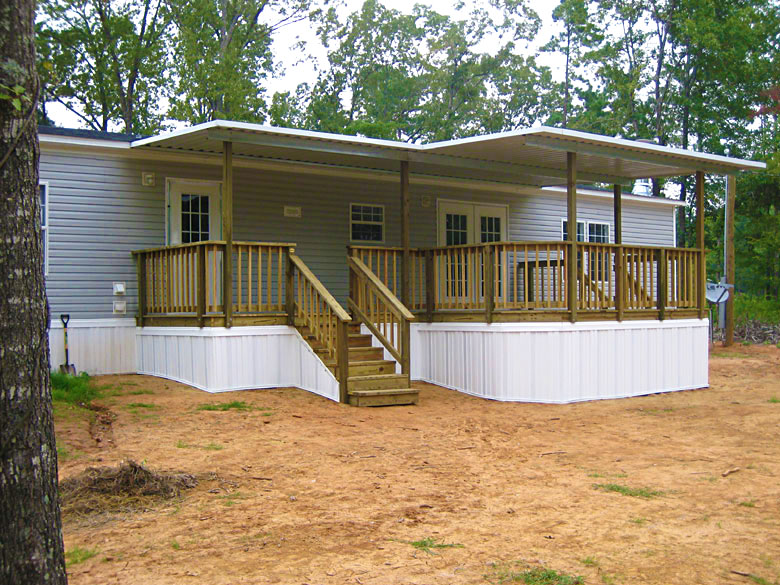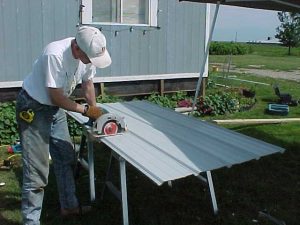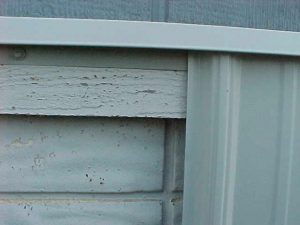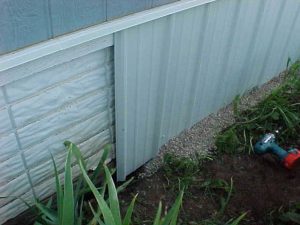Years and years ago the most common type of skirting for manufactured homes was metal. However, back then most metal skirting had that colorless galvanized look. Soon, other types of skirting found their way onto the market, namely vinyl and thermal.
Today metal skirting deserves another look. Unlike skirting of years past, galvanized metal is now available in many baked-on colors and shapes. With proper insulation metal skirting has many definite advantages. For instance, it’s much more rigid than vinyl, very maintenance free unlike thermal, will not blow off and can be easily insulated. Plus, it’ll look great for years, seals underneath the home against rodents and the cost of the materials isn’t any greater than that of other skirting options (although it may take longer to install).
Installation Instructions
Below is one recommended method for installing galvanized metal skirting. Materials you will need are galvanized metal in your choice of color, matching self-tapping screws with rubber washers, J-Channel for top track, corner channel, treated 2×4’s, wooden stakes, 3-1/2″ galvanized screws, pea rock and vents.
1. Install top track.
Screw J-Channel about 4″ up from the bottom of the home. If possible, use the existing trim or the bottom row of vinyl siding as a guide. If none, then snap a chalkline. You do not have to remove the bottom row of siding, but hardboard trim should be removed prior to installing the J-Channel. The top edge of the skirting will fit into this J-Channel. Install completely around the home.
2. Establish bottom of skirting location.
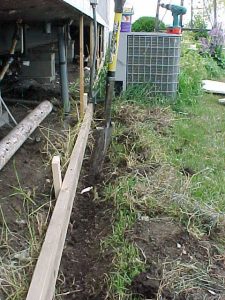 At each corner, hang down a plumb-bob and pound a big nail or piece of rebar. Do this to all four corners. Tie a mason’s string to one of the nails, and pull tight around the perimeter of the home tying it to all the corner nails. Double-check with a level to be sure the string line along the ground is straight down from the edge of the mobile home.
At each corner, hang down a plumb-bob and pound a big nail or piece of rebar. Do this to all four corners. Tie a mason’s string to one of the nails, and pull tight around the perimeter of the home tying it to all the corner nails. Double-check with a level to be sure the string line along the ground is straight down from the edge of the mobile home.
3. Install bottom support.
Behind but next to the string line, cut and lay on edge enough green-treated 2×4’s to go around the perimeter of the home. Behind the 2×4’s pound wooden stakes every 4-6 feet. Lift the 2×4’s about 1 inch off of the ground and screw one 3-1/2″ galvanized screw into each stake. Don’t screw tight.
4. Prepare pea-rock base.
In front of the 2×4’s, dig a 6″ deep trench with a spade around the perimeter of the home. Be careful around the stakes. For now, fill the trench with 2″ of small pea rock.
5. Install skirting.
Measure and cut metal ribbed sheets to length. Sheets should fit under J-channel and on top of pea rock. Measure the sheets often, as the lengths could change as often as every 3 feet. Screw sheets to bottom 2×4 support and at top. Also add one screw in middle of seam. Use self-tapping screws that match the color of the metal. Dress up the corners with corner channel. If desired, cut insulation board and put behind the skirting. Set the insulating boards on top of the bottom 2×4. With a tight cut, the top will be secured in place by the hanging belly.
6. Complete pea-rock base.
Once skirting is cut and screwed in and insulation is applied, fill trench to top with pea rock. The peak rock serves two purposes. First, it does an excellent job of keeping rodents out from underneath your home. Second, if the ground would heave or swell, the pea rock will push up around the skirting reducing the chance of the skirting shifting up.
7. Build vents and doors.
Cut holes and install air vents into skirting (see below). Also install two doors, one on each side. For convenience, locate one door near the water shut-off.
Venting caution
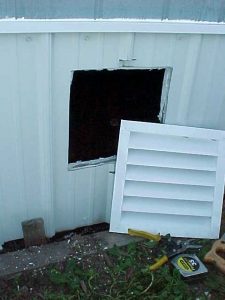 At a minimum, skirting must be vented in all four corners. A good rule of thumb is at least one square foot of open vent area per 150 square foot of floor area. Keep in mind that vents with insect screens, louvers etc reduce the effective open area of the vent by 30-50%. Since you’ll want insect screens and louvers on your skirting vents, be sure to calculate the added 30-50% when determining the number of vents you will need to install in your skirting.
At a minimum, skirting must be vented in all four corners. A good rule of thumb is at least one square foot of open vent area per 150 square foot of floor area. Keep in mind that vents with insect screens, louvers etc reduce the effective open area of the vent by 30-50%. Since you’ll want insect screens and louvers on your skirting vents, be sure to calculate the added 30-50% when determining the number of vents you will need to install in your skirting.
Also, if you live on ground that tends to heave real bad during the winter, you may want to then use a deep J-Channel for the top track and not screw the metal panels to the home. Screw them only to the 2×4’s. When inserting the panels into the top J-Channel, do not push them all the way to the top. This method will give your skirting more space to shift or flex with the ground.
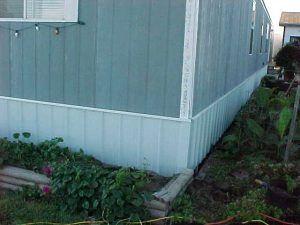 Because metal skirting is so rigid, landscaping is a breeze as you don’t have to worry about the dirt pushing in the skirting. A good idea is to put a piece of black plastic over the pea rock before spreading dirt.
Because metal skirting is so rigid, landscaping is a breeze as you don’t have to worry about the dirt pushing in the skirting. A good idea is to put a piece of black plastic over the pea rock before spreading dirt.
If you currently have thermal skirting, you could use it for insulation and apply the metal skirting in front of it (like many of these picture show.) If you don’t have old thermal skirting, you could add insulating board or bead board.

